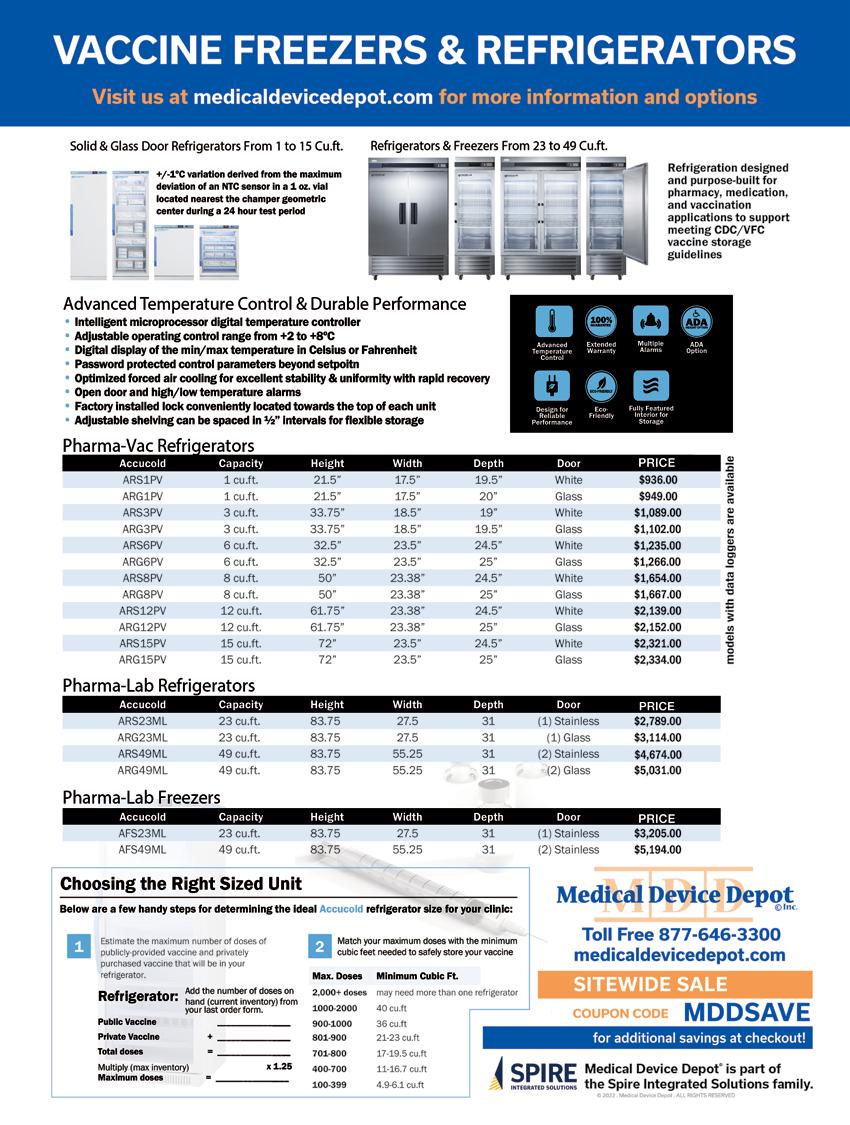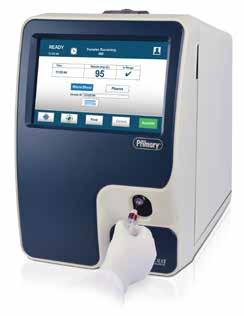
11 minute read
(olaparib) tablets, for oral use
First-Line Maintenance Treatment of BRCA-mutated Advanced Ovarian Cancer SOLO-1
The safety of Lynparza for the maintenance treatment of patients with BRCA-mutated advanced ovarian cancer following first-line treatment with platinum-based chemotherapy was investigated in SOLO-1 [see Clinical Studies (14.1) in the full Prescribing Information]. Patients received Lynparza tablets 300 mg orally twice daily (n=260) or placebo (n=130) until disease progression or unacceptable toxicity. The median duration of study treatment was 25 months for patients who received Lynparza and 14 months for patients who received placebo.
Among patients who received Lynparza, dose interruptions due to an adverse reaction of any grade occurred in 52% and dose reductions due to an adverse reaction occurred in 28%. The most frequent adverse reactions leading to dose interruption or reduction of Lynparza were anemia (23%), nausea (14%), and vomiting (10%). Discontinuation due to adverse reactions occurred in 12% of patients receiving Lynparza. The most frequent adverse reactions that led to discontinuation of Lynparza were fatigue (3.1%), anemia (2.3%), and nausea (2.3%).
Tables 2 and 3 summarize adverse reactions and laboratory abnormalities in SOLO-1.
Table 2 Adverse Reactions* in SOLO-1 (≥10% of Patients Who Received Lynparza)
* Patients were allowed to enter clinical studies with laboratory values of CTCAE Grade 1. † This number represents the safety population. The derived values in the table are based on the total number of evaluable patients for each laboratory parameter.
First-line Maintenance Treatment of HRD-positive Advanced Ovarian Cancer in Combination with Bevacizumab
PAOLA-1
The safety of Lynparza in combination with bevacizumab for the maintenance treatment of patients with advanced ovarian cancer following first-line treatment containing platinum-based chemotherapy and bevacizumab was investigated in PAOLA-1 [see Clinical Studies (14.2) in the full Prescribing Information]. This study was a placebo-controlled, double-blind study in which 802 patients received either Lynparza 300 mg BID in combination with bevacizumab (n=535) or placebo in combination with bevacizumab (n=267) until disease progression or unacceptable toxicity. The median duration of treatment with Lynparza was 17.3 months and 11 months for bevacizumab post-randomization on the Lynparza/bevacizumab arm.
Fatal adverse reactions occurred in 1 patient due to concurrent pneumonia and aplastic anemia. Serious adverse reactions occurred in 31% of patients who received Lynparza/bevacizumab. Serious adverse reactions in >5% of patients included hypertension (19%) and anemia (17%).
Dose interruptions due to an adverse reaction of any grade occurred in 54% of patients receiving Lynparza/bevacizumab and dose reductions due to an adverse reaction occurred in 41% of patients who received Lynparza/bevacizumab.
The most frequent adverse reactions leading to dose interruption in the Lynparza/bevacizumab arm were anemia (21%), nausea (7%), vomiting (3%), and fatigue (3%), and the most frequent adverse reactions leading to reduction in the Lynparza/bevacizumab arm were anemia (19%), nausea (7%), and fatigue (4%).
Discontinuation due to adverse reactions occurred in 20% of patients receiving Lynparza/ bevacizumab. Specific adverse reactions that most frequently led to discontinuation in patients treated with Lynparza/bevacizumab were anemia (4%) and nausea (3%).
Tables 4 and 5 summarize adverse reactions and laboratory abnormalities in PAOLA-1, respectively.
Table 4 Adverse Reactions* Occurring in ≥10% of Patients Treated with Lynparza/ bevacizumab in PAOLA-1 and at ≥5% Frequency Compared to the Placebo/bevacizumab Arm Adverse Reactions Lynparza/bevacizumab n=535 Placebo/bevacizumab n=267 ß Includes platelet count decreased, and thrombocytopenia. à Includes urosepsis, urinary tract infection, urinary tract pain, and pyuria. è Includes dyspnea, and dyspnea exertional.
* Graded according to the National Cancer Institute Common Terminology Criteria for Adverse Events (NCI CTCAE), version 4.0.
† Includes abdominal pain, abdominal pain lower, abdominal pain upper, abdominal distension, abdominal discomfort, and abdominal tenderness.
‡ Includes colitis, diarrhea, and gastroenteritis.
§ Includes stomatitis, aphthous ulcer; and mouth ulceration.
¶ Includes asthenia, fatigue, lethargy, and malaise.
# Includes neutropenia, and febrile neutropenia.
Þ Includes leukopenia, and white blood cell count decreased.
In addition, the adverse reactions observed in SOLO-1 that occurred in <10% of patients receiving Lynparza were increased blood creatinine (8%), lymphopenia (6%), VTE (3%), hypersensitivity (2%), MDS/AML (1%), dermatitis (1%), and increased mean cell volume (0.4%).
* Graded according to the National Cancer Institute Common Terminology Criteria for Adverse Events (NCI CTCAE), version 4.0.
† Includes asthenia, and fatigue.
‡ Includes anemia, anemia macrocytic, erythropenia, haematocrit decreased, haemoglobin decreased, normochromic anemia, normochromic normocytic anemia, normocytic anemia, and red blood cell count decreased.
§ Includes B-lymphocyte count decreased, lymphocyte count decreased, lymphopenia, and T-lymphocyte count decreased.
¶ Includes leukopenia, and white blood cell count decreased.
The most common adverse reactions (≥ 10%) for patients receiving Lynparza/bevacizumab irrespective of the frequency compared with the placebo/bevacizumab arm were nausea (53%), fatigue (including asthenia) (53%), anemia (41%), lymphopenia (24%), vomiting (22%), diarrhea (18%), neutropenia (18%), leukopenia (18%), urinary tract infection (15%), and headache (14%).
The adverse reactions that occurred in <10% of patients receiving Lynparza/bevacizumab were dysgeusia (8%), dyspnea (8%), stomatitis (5%), dyspepsia (4.3%), erythema (3%), dizziness (2.6%), hypersensitivity (1.7%) and MDS/AML (0.7%).
In addition, venous thromboembolic events occurred more commonly in patients receiving Lynparza/bevacizumab (5%) than in those receiving placebo/bevacizumab (1.9%).
Table 5 Laboratory Abnormalities Reported in ≥25% of Patients in PAOLA-1*
Table 7 Laboratory Abnormalities Reported in ≥25% of Patients in SOLO-2
* Reported within 30 days of the last dose.
† Patients were allowed to enter clinical studies with laboratory values of CTCAE Grade 1. ‡ This number represents the safety population. The derived values in the table are based on the total number of evaluable patients for each laboratory parameter.
Maintenance Treatment of Recurrent Ovarian Cancer
SOLO-2
The safety of Lynparza for the maintenance treatment of patients with platinum sensitive gBRCAm ovarian cancer was investigated in SOLO-2 [see Clinical Studies (14.3) in the full Prescribing Information]. Patients received Lynparza tablets 300 mg orally twice daily (n=195) or placebo (n=99) until disease progression or unacceptable toxicity. The median duration of study treatment was 19.4 months for patients who received Lynparza and 5.6 months for patients who received placebo.
Among patients who received Lynparza, dose interruptions due to an adverse reaction of any grade occurred in 45% and dose reductions due to an adverse reaction occurred in 27%. The most frequent adverse reactions leading to dose interruption or reduction of Lynparza were anemia (22%), neutropenia (9%), and fatigue/asthenia (8%). Discontinuation due to an adverse reaction occurred in 11% of patients receiving Lynparza.
Tables 6 and 7 summarize adverse reactions and laboratory abnormalities in SOLO-2.
Table 6 Adverse Reactions* in SOLO-2 (≥20% of Patients Who Received Lynparza)
* Patients were allowed to enter clinical studies with laboratory values of CTCAE Grade 1.
† This number represents the safety population. The derived values in the table are based on the total number of evaluable patients for each laboratory parameter.
‡ Represents the proportion of subjects whose mean corpuscular volume was > upper limit of normal (ULN). Study 19
The safety of Lynparza as maintenance monotherapy was evaluated in patients with platinum sensitive ovarian cancer who had received 2 or more previous platinum containing regimens in Study 19 [see Clinical Studies (14.3) in the full Prescribing Information]. Patients received Lynparza capsules 400 mg orally twice daily (n=136) or placebo (n=128). At the time of final analysis, the median duration of exposure was 8.7 months in patients who received Lynparza and 4.6 months in patients who received placebo.
Adverse reactions led to dose interruptions in 35% of patients receiving Lynparza; dose reductions in 26% and discontinuation in 6% of patients receiving Lynparza.
Tables 8 and 9 summarize adverse reactions and laboratory abnormalities in Study 19.
Table 8 Adverse Reactions* in Study 19 (≥20% of Patients Who Received Lynparza)
0
* Graded according to the National Cancer Institute Common Terminology Criteria for Adverse Events (NCI CTCAE), version 4.0.
† Represents grouped term consisting of abscess oral, aphthous ulcer, gingival abscess, gingival disorder, gingival pain, gingivitis, mouth ulceration, mucosal infection, mucosal inflammation, oral candidiasis, oral discomfort, oral herpes, oral infection, oral mucosal erythema, oral pain, oropharyngeal discomfort, and oropharyngeal pain.
‡ Represents grouped term consisting of anemia, hematocrit decreased, hemoglobin decreased, iron deficiency, mean cell volume increased and red blood cell count decreased.
In addition, the adverse reactions observed in SOLO-2 that occurred in <20% of patients receiving Lynparza were neutropenia (19%), cough (18%), leukopenia (16%), hypomagnesemia (14%), thrombocytopenia (14%), dizziness (13%), dyspepsia (11%), increased creatinine (11%), MDS/AML (8%), edema (8%), rash (6%), VTE (5%), and lymphopenia (1%).
* Graded according to NCI CTCAE v4.0.
† Represents grouped terms of related terms that reflect the medical concept of the adverse reaction. In addition, the adverse reactions in Study 19 that occurred in <20% of patients receiving Lynparza were dysgeusia (16%), dizziness (15%), dyspnea (13%), pyrexia (10%), stomatitis (9%), edema (9%), increase in creatinine (7%), neutropenia (5%), thrombocytopenia (4%), leukopenia (2%), MDS/AML (1%), VTE (1%), and lymphopenia (1%).
Table 9 Laboratory Abnormalities Reported in ≥25% of Patients in Study 19 Laboratory
* Patients were allowed to enter clinical studies with laboratory values of CTCAE Grade 1.
† This number represents the safety population. The derived values in the table are based on the total number of evaluable patients for each laboratory parameter.
‡ Represents the proportion of subjects whose mean corpuscular volume was > ULN.
(olaparib) tablets, for oral use
Postmarketing Experience
The following adverse reactions have been identified during post approval use of Lynparza. Because these reactions are reported voluntarily from a population of uncertain size, it is not always possible to reliably estimate their frequency or establish a causal relationship to drug exposure.
Immune System Disorders: Hypersensitivity including angioedema.
Skin and subcutaneous tissue disorders: Erythema nodosum, rash, dermatitis.
Drug Interactions
Use with Anticancer Agents
Clinical studies of Lynparza with other myelosuppressive anticancer agents, including DNA damaging agents, indicate a potentiation and prolongation of myelosuppressive toxicity.
Effect of Other Drugs on Lynparza
Strong and Moderate CYP3A Inhibitors
Coadministration of CYP3A inhibitors can increase olaparib concentrations, which may increase the risk for adverse reactions [see Clinical Pharmacology (12.3) in the full Prescribing Information]. Avoid coadministration of strong or moderate CYP3A inhibitors. If the strong or moderate inhibitor must be coadministered, reduce the dose of Lynparza [see Dosage and Administration (2.4) in the full Prescribing Information]
Strong and Moderate CYP3A Inducers
Concomitant use with a strong or moderate CYP3A inducer decreased olaparib exposure, which may reduce Lynparza efficacy [see Clinical Pharmacology (12.3) in the full Prescribing Information]. Avoid coadministration of strong or moderate CYP3A inducers.
Use In Specific Populations
Pregnancy
Risk Summary
Based on findings in animals and its mechanism of action [see Clinical Pharmacology (12.1) in the full Prescribing Information], Lynparza can cause fetal harm when administered to a pregnant woman. There are no available data on Lynparza use in pregnant women to inform the drug-associated risk. In an animal reproduction study, the administration of olaparib to pregnant rats during the period of organogenesis caused teratogenicity and embryo-fetal toxicity at exposures below those in patients receiving the recommended human dose of 300 mg twice daily (see Data). Apprise pregnant women of the potential hazard to the fetus and the potential risk for loss of the pregnancy.
The estimated background risk of major birth defects and miscarriage for the indicated population is unknown. The estimated background risk in the U.S. general population of major birth defects is 2-4%; and the risk for spontaneous abortion is approximately 15-20% in clinically recognized pregnancies.
Data
Animal Data
In a fertility and early embryonic development study in female rats, olaparib was administered orally for 14 days before mating through to Day 6 of pregnancy, which resulted in increased post-implantation loss at a dose level of 15 mg/kg/day (with maternal systemic exposures approximately 7% of the human exposure (AUC0-24h) at the recommended dose).
In an embryo-fetal development study, pregnant rats received oral doses of 0.05 and 0.5 mg/kg/day olaparib during the period of organogenesis. A dose of 0.5 mg/kg/day (with maternal systemic exposures approximately 0.18% of human exposure (AUC0-24h) at the recommended dose) caused embryo-fetal toxicities including increased post-implantation loss and major malformations of the eyes (anophthalmia, microphthalmia), vertebrae/ribs (extra rib or ossification center; fused or absent neural arches, ribs, and sternebrae), skull (fused exoccipital), and diaphragm (hernia). Additional abnormalities or variants included incomplete or absent ossification (vertebrae/sternebrae, ribs, limbs) and other findings in the vertebrae/ sternebrae, pelvic girdle, lung, thymus, liver, ureter, and umbilical artery. Some findings noted above in the eyes, ribs, and ureter were observed at a dose of 0.05 mg/kg/day olaparib at lower incidence.
Lactation
Risk Summary
No data are available regarding the presence of olaparib in human milk, or on its effects on the breastfed infant or on milk production. Because of the potential for serious adverse reactions in the breastfed infants from Lynparza, advise a lactating woman not to breastfeed during treatment with Lynparza and for one month after receiving the last dose.
Females and Males of Reproductive Potential
Pregnancy Testing
Recommend pregnancy testing for females of reproductive potential prior to initiating treatment with Lynparza.
Contraception
Females
Lynparza can cause fetal harm when administered to a pregnant woman [see Use in Specific Populations (8.1) in the full Prescribing Information]. Advise females of reproductive potential to use effective contraception during treatment with Lynparza and for at least 6 months following the last dose.
Pediatric Use
Safety and effectiveness of Lynparza have not been established in pediatric patients.
Geriatric Use
Of the 2901 patients with advanced solid tumors who received Lynparza as a single agent, 680 (23%) patients were aged ≥65 years, and this included 206 (7%) patients who were aged ≥75 years. Thirteen (0.4%) patients were aged ≥85 years.
Of the 535 patients with advanced solid tumors who received Lynparza tablets 300 mg orally twice daily in combination with bevacizumab, 204 (38%) patients were aged ≥65 years, and this included 31 (6%) patients who were aged ≥75 years.
No overall differences in the safety or effectiveness of Lynparza were observed between these patients and younger patients.
Renal Impairment
No dosage modification is recommended in patients with mild renal impairment (CLcr 51 to 80 mL/min estimated by Cockcroft-Gault). Reduce Lynparza dosage to 200 mg twice daily in patients with moderate renal impairment (CLcr 31 to 50 mL/min) [see Dosage and Administration (2.5) in the full Prescribing Information]. There are no data in patients with severe renal impairment or end-stage disease (CLcr ≤30 mL/min) [see Clinical Pharmacology (12.3) in the full Prescribing Information]
Hepatic Impairment
No adjustment to the starting dose is required in patients with mild or moderate hepatic impairment (Child-Pugh classification A and B). There are no data in patients with severe hepatic impairment (Child-Pugh classification C) [see Clinical Pharmacology (12.3) in the full Prescribing Information]
Distributed by:
AstraZeneca Pharmaceuticals LP
Wilmington, DE 19850
©AstraZeneca 2022
10/2022 US-70178 11/22
2925
DIABETES/BLOOD GLUCOSE INSULIN INSIGHTS
From Semler Scientific
Using algorithms that codify the ADA standards of care Insulin Insights’ game-changing technology empowers clinicians with actionable data to help inform insulin dosing decisions. This FDA-cleared software as a medical device aims to improve diabetic patient outcomes, lower glycated hemoglobin, and reduce the risk of long-term complications. It is the only comprehensive dosing solution for all patients and insulin regimens.

View Brochures, Videos & More at POR.io
Enter Number 2925 in the Search Area
Nova Primary Blood Glucose Reference Analyzer

From Nova Biomedical
The U.S. FDA has cleared Nova Primary as a blood glucose reference analyzer that fills the need for a new reference analyzer to replace the YSI STAT PLUS 2300 (YSI, Inc., Yellow Springs, OH). Manufacturers of blood glucose measuring devices and clinical diabetes researchers have relied on the YSI 2300 as a reference and correlation analyzer. However, YSI, Inc. no longer supports the analyzer, and its discontinuation has left a critical industry void. With today’s FDA clearance, Nova Primary from Nova Biomedical is now available in the U.S. and worldwide.
View Brochures, Videos & More at POR.io
Enter Number 2926 in the Search Area
2926
2927
COMPREHENSIVE IN-OFFICE DIABETES TESTING WITH THE DCA VANTAGE® AND CLINITEK STATUS®+ ANALYZERS
From Siemens Healthineers
Siemens Healthineers DCA Vantage® and CLINITEK Status® family of analyzers provide hemoglobin A1c (HbA1c) and albuminto-creatinine ratio (ACR) testing at the point of care. Meet quality measures for A1c control and kidney disease check in minutes with CLIA-waived HbA1c testing and ACR1 ratio. Improve patient experience and overall outcome by providing actionable results in minutes.
View Brochures, Videos & More at POR.io
Enter Number 2927 in the Search Area










